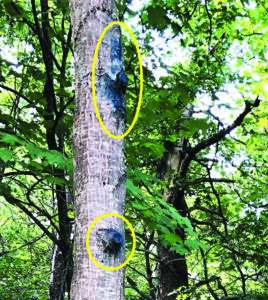
Flail mowers can make work easier and more productive for town crews, but the Wisconsin Department of Natural Resources urges workers and managers to save any work that could damage oak trees for fall and winter, when the risk of the fungal disease oak wilt is minimal. / Photo Credit: Wisconsin DNR
By Art Kabelowsky, DNR Outreach and Communications, Fitchburg;
Arthur.Kabelowsky@wisconsin.gov or 608-335-0167
Do you know of a state, county, municipal or private crew that has been itching to do some work involving oak trees? Or are you a landowner itching to do some oak pruning or cutting?
Well, the time has arrived for smart and safe work on oaks.
It’s important for crews and managers to know that any damage done to oak trees from April 1 through at least mid-July — many say into September — could lead to a quick death for that tree. Frequently, one tree’s infection will also lead to eventual mortality for neighboring oaks.
That’s a problem for officials who are proud of the mature, high-value oak trees that line their parks, trails, campgrounds and roadways. And it’s a problem for crews which then face the time, expense and hazard of removing the dead trees.
This source of the problem is the scourge of oak wilt, a deadly fungal disease that is spread — often very quickly — by beetles that carry fungal spores and are attracted to freshly wounded trees.

Photo of oak leaves that have fallen from a tree infested with oak wilt fungus. They show bronze-and-green coloration and will appear water-soaked but partially green. Trees in the red oak family that are infected with oak wilt will die during late summer or early fall of the same year that they are infected. / Photo Credit: Wisconsin DNR
“It’s a serious disease,” said Kyoko Scanlon, a forest pathologist for the Wisconsin Department of Natural Resources (DNR). “Trees in the red oak group (most commonly northern red, northern pin and black oak) are very susceptible and show the worst symptoms. Trees will lose most of their leaves and die within as little as a month of showing symptoms.”
Oak wilt also causes decline and often mortality for bur oak and swamp white oak trees, though mortality could take years. Some trees in the white oak family can survive oak wilt, though decline will often be noticeable. For all oak trees, infection can spread through the trees’ interconnected root systems to eventually kill neighboring oak trees.
All this trouble can be sparked when a native-to-Wisconsin beetle smells a fresh wound on an oak tree – whether caused on purpose, by accident, by people or through a naturally occurring event. Workers can even cause damage without knowing it if a flail or chop mower happens to contact a roadside oak.
About one year after infected trees die, fungal mats full of spores develop under the bark. Beetles are attracted to these areas. As they feed, fungal spores hitch a ride on their bodies. Then, when beetles sense a nearby tree has suffered a wound, their attention quickly shifts as they buzz over to the wounded tree, infecting it with the hitchhiking fungal spores.
It doesn’t take long for beetles to flock to a damaged oak.
“It can take only 10-15 minutes after a pruning wound,” Scanlon said. “A fresh wound is susceptible to infection for up to 72 hours before it dries out.”
And the wound doesn’t have to be a big one.
“It could even be as small as spike wounds from the spikes arborists used to wear on their shoes while climbing a tree,” said Scanlon.
The fungus grows through the tree’s water-conducting system, leading to the telltale “wilt” look that shows up on a tree’s discolored, green-and-brown leaves. The leaves fall prematurely, and the tree doesn’t recover.
“The tree tries to contain the infection by shutting off its water flow, which does more harm than good,” noted Scanlon.

In case an oak tree is pruned, cut or otherwise damaged between April and mid-July, intentionally or not, it is best to carry latex tree wound paint in order to cover the wound immediately. / Photo Credit: Wisconsin DNR
The most significant danger period for oak wilt infection is determined by that year’s weather conditions, but generally runs from April 1 through mid or late July. However, some trees can remain susceptible throughout the entire summer. Some towns and municipalities have created ordinances that ban work on oak trees from April through September.
If a tree is damaged during the “danger period,” fast-acting crews can prevent oak wilt infection. Crews are urged to carry a supply of fungicidal tree-wound paint on their work vehicles so they can stop and cover a wound the instant it is made.
But after the first frost of the fall/winter, the risk of infection stops. This time of year, crews can safely do the work on oak trees they have been planning.
“In most cases, winter is the best time for pruning oak trees, anyway,” shared Scanlon. “After the leaves fall, it’s easier to see the branches that need work and ensure nothing is missed.”
For more information about oak wilt, including harvesting tips, an interactive guide and maps, visit the DNR’s Oak Wilt webpage.
Learn more by subscribing to DNR’s Forest Health newsletter.
